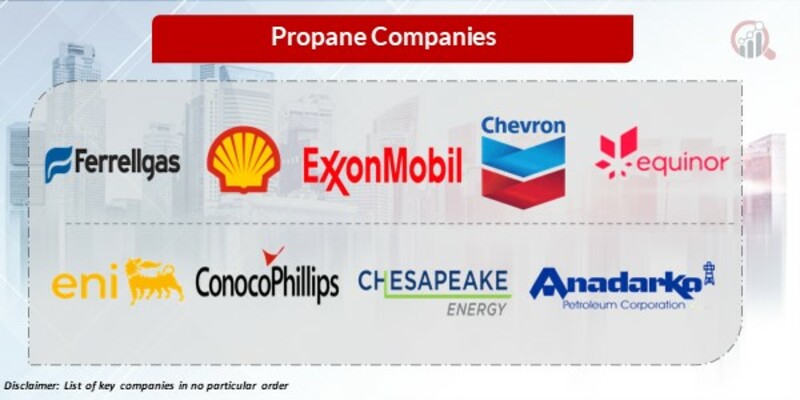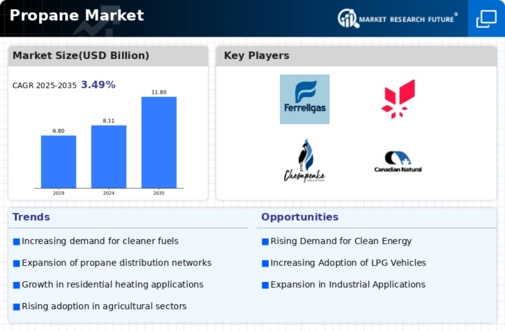Top Industry Leaders in the Propane Market
 Propane, the versatile champion of clean and convenient energy, is experiencing a resurgence. From powering rural homes and off-grid businesses to fueling grills and industrial processes, propane caters to diverse needs, fostering a dynamic and competitive market landscape.
Propane, the versatile champion of clean and convenient energy, is experiencing a resurgence. From powering rural homes and off-grid businesses to fueling grills and industrial processes, propane caters to diverse needs, fostering a dynamic and competitive market landscape.
Market Share: A Balancing Act on a Gas Cylinder
Several factors influence who gets the lion's share in this intricate market:
-
Application Scope: The market spans diverse segments like residential heating, commercial and industrial uses, agriculture, and recreational applications. Each segment has its specific needs, influencing propane demand and market dynamics. -
Geographical Distribution: North America leads the charge, boasting extensive infrastructure and well-established propane markets. However, Asia Pacific and Latin America are witnessing significant growth, driven by urbanization and energy diversification efforts. -
Energy Prices: Fluctuations in the price of natural gas and other alternative fuels directly impact the competitiveness of propane, influencing its market share. -
Environmental Regulations: Stringent regulations on carbon emissions and air pollution are driving the adoption of propane as a cleaner fuel source, boosting its market appeal. -
Player Strategies: From established energy giants like ExxonMobil and Shell to regional distributors and local propane companies, the market encompasses a diverse range of players. Their strategies range from infrastructure expansion and technological advancements to safety initiatives and partnerships with appliance manufacturers.
Strategizing for Success: Securing a Foothold in the Propane Battlefield
Players in the propane market are wielding their expertise to secure their share:
-
Infrastructure Expansion: Investing in pipelines, storage facilities, and distribution networks increases accessibility and market reach, particularly in emerging regions. -
Technological Advancements: Implementing smart metering technologies, automation solutions, and remote monitoring systems optimizes delivery, enhances safety, and improves customer experience. -
Safety Focus: Emphasizing the safety record of propane and promoting best practices fosters trust and consumer confidence, especially compared to alternatives like fossil fuels. -
Propane Appliance Partnerships: Collaborating with appliance manufacturers to develop new and efficient propane-powered technologies, like home heating systems and cooking appliances, expands market demand and consumer adoption. -
Sustainability Initiatives: Highlighting the lower carbon footprint and environmental benefits of propane compared to traditional fuels, such as reduced greenhouse gas emissions and cleaner air quality, resonates with environmentally conscious consumers and aligns with green regulations.
Key Players:
- Ferrellgas (US)
- Royal Dutch Shell plc (Netherlands)
- Exxon Mobil Corporation (US)
- Chevron Corporation (US)
- Equinor ASA (Norway)
- Eni SpA (Italy)
- ConocoPhillips Company (US)
- Chesapeake (US)
- Anadarko Petroleum Corporation (US)
- Canadian Natural (Canada)
Recent Developments:
August 2023: Shell, a major propane supplier, announces plans to expand its propane infrastructure in China to cater to the rising demand in the Asian market.
September 2023: The US Department of Energy launches a new program promoting the use of propane for clean heating in rural communities.
October 2023: A consortium of leading universities unveils a breakthrough in propane-based fuel cell technology, offering significant efficiency improvements and cost reductions.
November 2023: Major appliance manufacturers announce the launch of new propane-powered lines, including generators and lawnmowers, catering to the growing demand for off-grid solutions.
December 2023: Several European countries announce plans to adopt propane as a bridge fuel in their transition to renewable energy sources, highlighting its role in decarbonization efforts.

